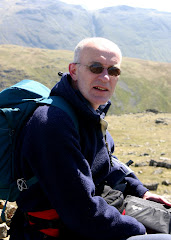Day 7 does pay a last brief visit to the Wall but it can't be denied that the pinnacle is passed and Haltwhistle itself had gone nothing to improve Wainwright's demeanour.
I had stayed at the Grey Bull in 1998 as had Wainwright 60 years earlier and any information about the owners in 1938. From Haltwhistle the old and new routes find their way following Haltwhistle Burn north to the main road after which a minor road leads back to the wall.

Following the wall westwards the route continues as far as Carvoran (now a Roman Museum) passing a disused quarry lying just to the north of the wall. I would be interested to know more about the quarry as it is suggested that it was still in operation on the old map and presents a huge eyesore and is an ugly blot on the landscape. There is an aerial ropeway marked on the old map which presumably served the quarry taking the rock down to the railway - confirmation would be useful.
At Carvoran the routes diverge as Wainwright proceeded into Greenhead. The new route follows a minor road before crossing meadows and the Tippalt Burn near College Farm (why that name?) then over the railway and road and onto another minor road heading south toward Featherstone Common.

A short road walk takes the new route to join the old where they proceed along the Maiden Way, the old Roman road that Wainwright had tried to follow. South of Lambley it is easy to track because once again Wainwright had found himself walking the route that was to become part of the Pennine Way some 30 years after he had come this way.

Slaggyford found favour with Wainwright for its "complete tranquility" and in 1998 the old railway station was very tranquil for it, like so many other, is now dead. It was a delightful little station and can be imagined as being bedecked with flower baskets in earlier times tended by a keen station master. Any details about this remnant of a past life would be very interesting.
The railway track continues south where the tiny dots on the old map between Wainwright's route and the new route is actually the Pennine Way and all three cross the river South Tyne to the footbridge that Wainwright was very pleased to discover having thought he would have to ford the river. The footbridge is a sizable structure in the middle of nowhere and its building must have a history as to why its there - any details would be gratefully received.

Once the river is crossed it is a short walk on minor roads into England's highest market town, Alston. Passing Kirkside Wood Alston is less than 2 miles. A stretch of the railway has been rescued hereabouts by volunteers as the South Tynedale Railway and it runs in the valley below the path which rises before descending again into Alston.





































